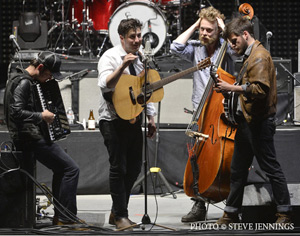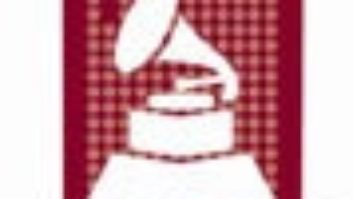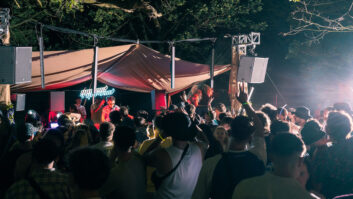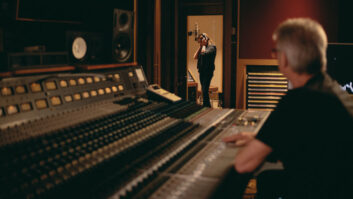
From left: Ben Lovett, Marcus Mumford, Ted Dwane, and Winston Marshall
Photo: Steve Jennings
Mix caught Mumford & Sons during a three-night, sold-out run at the Greek Theatre in Berkeley, Calif., just prior to the announcement of bassist Ted Dwane’s surgery and the cancellation of dates on the Stampede Tour. Our thoughts are with him.
FOH engineer Chris Pollard, pictured at left, mixes on a Midas XL4, which he chose for its sound—the preamps, EQ and its wide dynamic range. “I used to mix the band on digital consoles,” he says, “but when the chance to switch over arose, I thought it could be a better choice for the sound of the band, and also a great chance to really learn the sound of all these compressors and FX that a lot of software is emulating. My setlist is programmed in as scenes, but that only allows for VCA, Aux, Mute and MIDI changes. I like the focus that brings to my mix.

FOH engineer Chris Pollard (left) and system tech Jamie Howieson
Photo: Steve Jennings
“I use a range of classic live sound compressors—the UA1176 for lead vocal, Summit DCL200s for secondary vocals, Distressors for guitars—but my favorites are the TubeTech multiband compressor and Alan Smart C2 limiter, which are inserted in stereo over the main mix. For lead vocal I use the MMC1A multiband compressor in line with a UA1176N. Toward the end of the show, Ben, Marcus, Ted and Winston gather around a Shure KSM 44 set to figure-8. The horn section is using Shure KSM313s, ribbon microphones, a new addition. Very smooth-sounding microphone, very natural.”
“For the Greek shows Solotech provided an L-Acoustics rig with eight K1s per side for main hang, eight SB 2B subwoofers per side stacked, 12 KARA front fills stacked and two ARCs for outfills,” adds system tech Jamie Howieson, pictured right. “The system is powered by LA 8 Power amps with LA Network Manager control. It changes a bit for shed or arena shows.”

Monitor engineer Joel Gregg
“I’m on a DiGiCo SD10, with no external plug-ins, running at 96k,” says monitor engineer Joel Gregg. “It’s pretty full—close to 90 inputs and I’m up in the mid-40s for my outputs. It’s such a busy mix I’m reluctant to add more things. I make sure that levels are right and cues are followed. Two DiGiCo SD racks are hooked up to the control surface via optical, and on top of each of those we have two Galileos that are running Meyer MJF212a wedges. We record every show via the DiGiCo UB MADI device. But we have to pick our 48 channels to track.
“My entire setup relies on my monitor tech, Fabrice Quirin,” he adds. “He runs RF coordination, patch, and basically runs monitor world through the whole day. We use Ultimate Ears for our IEMs. For wireless, we use Shure PSM1000s and a few PSM900s, with two Shure 8-way combiners that we bump down to one helical antenna so everyone’s ears run off the one source. Altogether there are 18 receivers dotted around the place.”
“On Marcus’ full kit we have a Beta 52 in the kick, Beta 57s on snare top and bottom, SM81 on hats, Beta 98s on all the toms and KSM141 overheads,” says drum tech Ivan Boneyard. “Marcus’ single front kick down front has a Beta 91 inside and 52 in the hole.”





